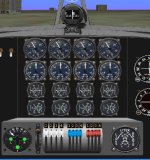Hello Ivan,
I´m back, and it´s easier to post on a proper computer than on the mobile phone... The doctor was not too bad either!
I´m glad you got a better working propeller for your Ki-61.
From what I gather, compared to the Stock P51d propeller, you have improved S.L. performance with the same horsepower. Great!
If you want to continue using this thread for a possible propeller prop shop, please do so, especially if you find it easier.
After all, propellers is one of the important themes as regards the development of an improved Condor .air file. The original propeller data I had, turned out totally wrong for this version, which is now improving notably.
You were asking about how I chose this path for Gauges. My original and now discarded path, had always been to use stock or FSFSConv gauges, because I thought they were good enough, but as it turned out, some of them aren´t!
Fortunately, the most important not-good-enough gauges have been extremely well substituted by your great RPM and Boost Gauges. Then, the rest of the gauges that functionally are good enough, are now being modded-up in my shop so that they match the set you made.
I´m glad you like the gauge faces! Maybe I should turn a screw here and there...
All Cut and Paste... and for the letters, I had to build the ones I didn´t have from bits and pieces of those that were on the FSFSConv Gauges... also a bit pallette editing. A crazy way to work, really, but it works.
Your question on the fuel gauges I would need: If possible, that would be separate left and right 500 USG Wing Tanks.
If you are making any, I´d be happy to have some!
If the 500 USG are inconvenient for you, I´ll take anything your curiosity would like to play with.
If you weren´t going to make any, at the moment I´d be modding the two square fuel Gauges of the Cessna 182 RG, giving them the old-fashioned, matching, rounded-square frame.
Update: It won´t work, there´s no space for the old-fashioned frame on the 2 sibe-by-side square Cessna fuel gauges. For the moment I´ll use my dual L/R Tank one until, and if perhaps, you come up with 2 separate Tank gauges.
Here´s a new screenshot of the functional Condor Panel.
I´m thinking of putting in some metal panel lines on the different gauge areas, and colouring the panel in a darker bluish-grey, not so blue as it is now.
OK, then!
Cheers,
Aleatorylamp



